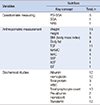Abstract
Purpose
The purpose of this study was to analyze the research trends of nursing researches done on cancer patients' nutrition in Korea and to make suggestions for future studies.
Methods
A total of 100 studies from 1989 to 2015 were analyzed. 22 nursing studies were selected for analysis the based on keywords 'nutrition', 'cancer' and 'patients'.
Results
Of 100 papers, 27 were doctoral dissertation and master's theses, 73 were from academic journals, 3 were thesis studies, and 19 were reported research in academic journal in nursing fields. Quantitative researches accounted for 92.0% while 20% among them were nursing researches, and other types of studies were 2%. The most frequently used research type was non-experimental 65.0%, while the ratio of experimental researches was 27.0%. The most frequently used research subjects were cancer patients without diagnostic classification with 37.0%. The most common issue of qualitative studies was the patient's nutrition condition.
Figures and Tables
Table 1
Number of Research by Year and Origin (N =100)

Table 2
Research by Design Analysis (N =100)

Table 3
Research by Subject Analysis (N =100)

Table 4
Number of Nursing Research by Key Concept Analysis (N =22)

PG-SGA=Patient-generated subjective global assessment; SGA=Subjective global assessment; NRS=Nutrition risk score; TSF=Triceps skinfold thickness; MAMC=Mid-arm muscle circumference; MAC=Mid-arm circumference; SSF=Scapula skinfold thickness; ASF=Abdomen skinfold thickness; ISF=Iliac crest skinfold thickness; WBC=White blood cell.
References
1. Min HS, Hwang WH. The Effects of nutritional education program on nausea and vomiting, anorexia, food intake, and nutritional status of GI cancer patients undergoing chemotherapy. J Korean Oncol Nurs. 2010; 10(1):38–47.
2. Wie KA. Prevalence and risk factors of malnutrition according to tumor location and stage in cancer patients [master's thesis]. Seoul: Seoul National Univ.;2005.
3. Van Cutsem E, Arends J. The causes and consequences of cancer-associated malnutrition. Eur J Oncol Nurs. 2005; 9(2):51–63.

4. Yang YH, Kwon SJ, Kim CI. The nutritional status of the patients with cancer during the chemotherapies. J Korean Acad Nurs. 2001; 31:978–987.

5. Jun MH, Wang SG. The longitudinal study on the calorie and protein intakes and food choices in gastrectomy patients who receiving adjuvant chemotherapy. J Korean Acad Nurs. 2002; 32:206–220.

6. Lis CG, Gupta D, Lammersfeld CA, Markman M, Vashi PG. Role of nutritional status in predicting quality of life outcomes in cancer: a systematic review of the epidemiological literature. Nutr J. 2012; 11:27.
9. Lis CG, Gupta D, Lammersfeld CA, Markman M, Vashi PG. Role of nutritional status in predicting quality of life outcomes in cancer-a systematic review of the epidemiological literature. Nutr J. 2012; 11:27.
10. Gupta D, Lammersfeld CA, Vashi PG, Dahlk SL, Lis CG. Can subjective global assessment of nutritional status predict survival in ovarian cancer? J Ovarian Res. 2008; 1(1):5.

11. Park EH, Kim HJ. Nutritional status and fatigue in women cancer patients receiving chemotherapy. J Korean Acad Fundam Nurs. 2015; 22(4):387–397.

12. Park KO, Choi KS. Effects of individualized nutritional education programs on the level of nutrient intake and nutritional status of colorectal cancer patients undergoing palliative chemotherapy. J Korean Acad Nurs. 2012; 42(6):799–809.

13. Jun MH, Kim MJ, Choi KS, Kim DH. The effect factors of quality of life on patients undergoing chemotherapy after stomach cancer surgery. J Korean Oncol Nurs. 2002; 2:83–93.
14. Yalcin N, Cihan A, Gundogdu H, Ocakci A. Nutrition knowledge level of nurses. Health Sci J. 2013; 7(1):99–108.
15. Lavdaniti M. A nursing perspective of nutrition in cancer patients undergoing chemotherapy. Prog Health Sci. 2014; 4(2):131–134.
16. Pradignac A, Petitdemange AM, Séry V, Hubsch A, Ben Ayed C, Schlienger JL. A nutritional education program for the nursing staff may improve hospitalized patients’ nutritional assessment and management. E Spen Eur E J Clin Nutr Metab. 2011; 6(2):e53–e58.

17. Bjerrum M, Tewes M, Pedersen P. Nurses’ self reported knowledge about and attitude to nutrition–before and after a training programme. Scand J Caring Sci. 2012; 26(1):81–89.

18. Park JS, Kim HO, Moom MY, Oh YJ, Jung KI, Yoon MO, et al. Analysis of researches about nutrition, pain and fatigue of cancer patients. J Korean Acad Community Health Nurs. 2002; 13(3):541–555.
19. Molassiotis A, Gibson F, Kelly D, Richardson A, Dabbour R, Ahmad AM, et al. A systematic review of worldwide cancer nursing research: 1994 to 2003. Cancer Nurs. 2006; 29:431–434.
20. Chung BY, Yi MS, Choi EH. Trends of nursing in the Journal of Oncology Nursing. J Korean Oncol Nurs. 2008; 8:61–66.
21. Oh PJ. An integrative review of oncology nursing research in Korea: 2003-2008. J Korean Oncol Nurs. 2010; 10:80–87.
22. Shin HS, Hyun MS, Ku MO, Cho MO, Kim SY, Jeong JS, et al. Analysis of research paper in the Journal of Korean Academy of nursing-focused on research trends, intervention studies, and level of evidence in the research. J Korean Acad Nurs. 2010; 40(1):139–149.

23. Choe MA, Kim NC, Kim KM, Kim SJ, Park KS, Byeon YS, et al. Trends in nursing research in Korea: research trends for studies published from the inaugural issue to 2010 in the Journal of Korean Academy of Nursing and the Journals published by member societies under korean academy of nursing science. J Korean Acad Nurs. 2014; 44(5):484–494.

24. Lee EO, Lim NY, Park HA, Lee IS, Kim JI, Bai JI, et al. Nursing research and statistical analysis. 1st ed. Paju: Soomoonsa;2009.
25. Kim SH, Kim MY, Kim SH, Kim HK, Lee IS, Lee JY, et al. Trends of studies published in Asian Oncology Nursing, 2011-2014. J Korean Oncol Nurs. 2015; 15(2):114–122.

26. Rha MY. Effects of clinical outcome of hospitalized patients by means of nutritional status [dissertation]. Seoul: Seoul National Univ;2006.
27. Oh PJ, Yoo JH. A meta-analysis of intervention studies on nausea and vomiting in cancer patients. Korean J Adult Nurs. 2011; 23(4):340–350.




 PDF
PDF ePub
ePub Citation
Citation Print
Print


 XML Download
XML Download